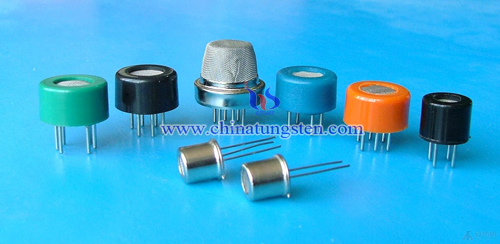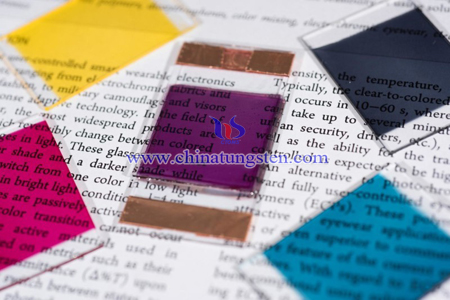As-Reduced Ammonium Tungsten Bronze Nanoparticles Preparation
- Details
- Category: Tungsten Information
- Published on Tuesday, 14 June 2016 17:36
Tungsten bronze compounds are an important class of inorganic compounds, such compounds of tungsten ions W6 +, W5 + and W4 + and other mixed valence state so that the overall charge balance compound. Rich crystal structure, the structure of the tunnel and this particular valence state to have excellent properties, such as electronic and ionic conductivity, superconductivity, optical properties, which in the secondary battery, electrical system color, and near-infrared absorption application of chemical sensors and other aspects of widespread research interest.
Currently, the synthesis of compounds of tungsten bronze Lei depends on the wet chemical method, a thermal reduction and thermal decomposition. Wet chemical synthesis of ammonium tungsten bronze is mainly starting material under reflux for several days in a reducing solvent, obtained by this method sample size is too large, usually between a few to tens of microns, and the preparation process for a long time , energy consumption. Thermal reduction sucked tungsten oxide, a tungsten metal powder and metal tungstates uniformly mixed in proper proportions, then heated in a vacuum or under an inert atmosphere, the reaction temperature is usually about 1000 ° C, to remove unreacted after completion of the reaction impurities. Since the thermal stability of ammonium tungsten bronze difference, decomposition temperature (300 ° C) below the synthesis temperature, the thermal reduction can not be used to synthesize ammonium tungsten bronze. Pyrolysis synthesis of ammoniumtungsten bronze is ammonium paratungstate in a reducing atmosphere (H2 or H2 and N2, a mixed gas of Ar, etc.) under thermal decomposition, in addition to the resulting sample size is too large, but this method also can not be ammonium tungstate completely pure phase bronze, ammonium content of the sample is too low and easy to excessive oxidative decomposition of the crane and other shortcomings.
As the current study can not directly produce ammonium tungsten bronze Nanopowders pure phase, it is often the large micron-sized particles obtained by milling the way broken into small particles, but such compounds during the milling process is easy It is oxidized and inactivated and easy to break down, but also accompanied by a crystallization performance degradation and other shortcomings, and therefore has no way to step directly nano ammonium tungsten bronze powder.
Restore preparing ammonium tungsten bronze nanoparticles, wherein the method steps are as follows: 0.01 ~ 1g organic tungsten source was dissolved in 20 ~ 40ml organic acid solution, and stirred to obtain a homogeneous solution, then adding 4 ~ 30ml organic amines, mixed until homogeneous, to move the reaction vessel, 150 ~ 350 ° C crystallization for 0.5 to 48 hours, the reaction was powder samples were centrifuged, washed, at 40 to 250℃ vacuum drying 1 ~ 12 hours i.e. get the reduced form ammonium tungsten bronze nanoparticles.
The present invention under solvothermal conditions, the long-chain organic acid is a high boiling point reaction media, organic tungsten source and a high-boiling organic amines as raw materials in a non-aqueous environment next ammonium tungsten bronze controlled synthesis of nanoparticles. A significant advantage of this method is that the synthesis of simple steps can yield, to thereby obtain a uniform particle morphology, crystallinity is good, narrow particle size distribution, size is adjustable within a certain range, the chemical valence of reduced state, without the need for prolonged process and subsequent milling process, direct access to nano-powders.
The present invention is a sample preparation hexagonal tungsten bronze ammonium nanocrystals size between 80 ~ 500nm can be regulated, uniform shape, a narrow particle size distribution, the valence state and W6 +, W5 + mixed, rich in free electrons. Further, the samples of the present invention is prepared having strong near-infrared absorbing ability, a film containing nanoparticles can effectively shield the near infrared rays of 780 ~ 2500nm and maintaining high visible light transmittance.


Example 1: The 0.4g tungsten chloride is dissolved in 20ml of oleic acid, stir until completely dissolved, then add 20ml oil amine and mixed until uniform, moved to supercritical autoclave, 350 ° C crystallization reaction 1 hour, the reaction after the powder body samples were centrifuged, washed, and dried in vacuo at 60 V for 6 hours to obtain a blue powder ammonium tungsten bronze, which is a square block of ammonium tungsten bronze particles, the average diameter of 250nm.
Example 2: 100ml of water after the hydrothermal reaction vessel was added 36ml of oleic acid and 0.4 g WCl4 powder was mixed at room temperature with stirring; until completely dissolved, then add 4 ml of oleyl amine, and then sealed reactor, in an oven at 200 ° C Crystal was allowed to stand of 24 h. After cooling to room temperature, centrifuged, and washed three times successively alternately with 30 mL deionized water and 30 mL of absolute ethanol, and dried under vacuum to give ammonium tungsten bronze blue powder, which is a square block of ammonium tungsten bronze particles, the average diameter of 200nm.

| Tungsten Oxide Supplier: Chinatungsten Online www.tungsten-oxide.com | Tel.: 86 592 5129696; Fax: 86 592 5129797;Email:sales@chinatungsten.com |
| Tungsten News & Prices, 3G Version: http://3g.chinatungsten.com | Molybdenum News & Molybdenum Price: http://news.molybdenum.com.cn |



 sales@chinatungsten.com
sales@chinatungsten.com